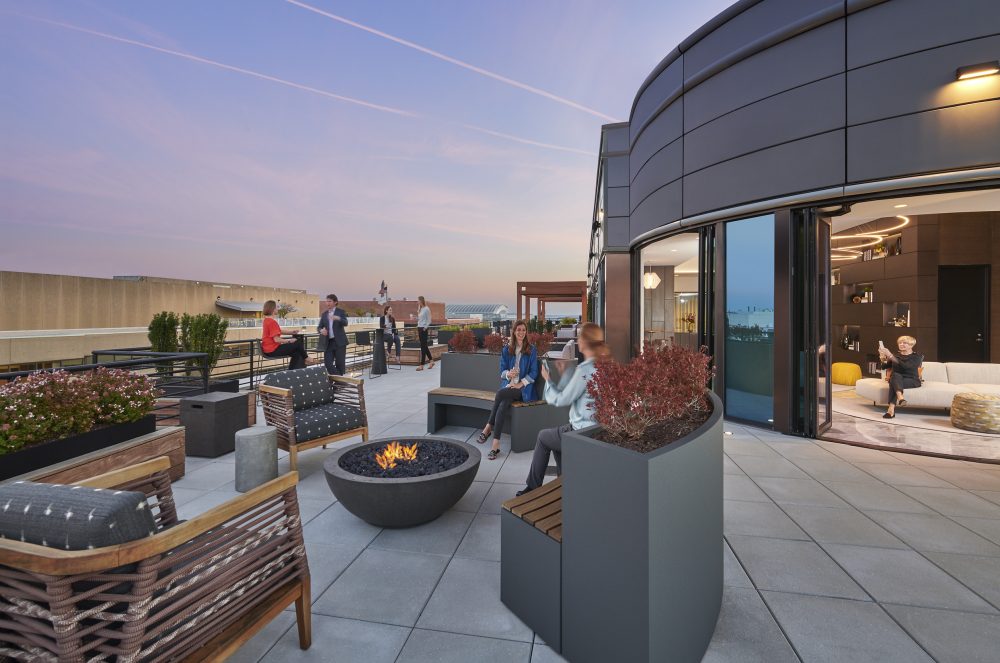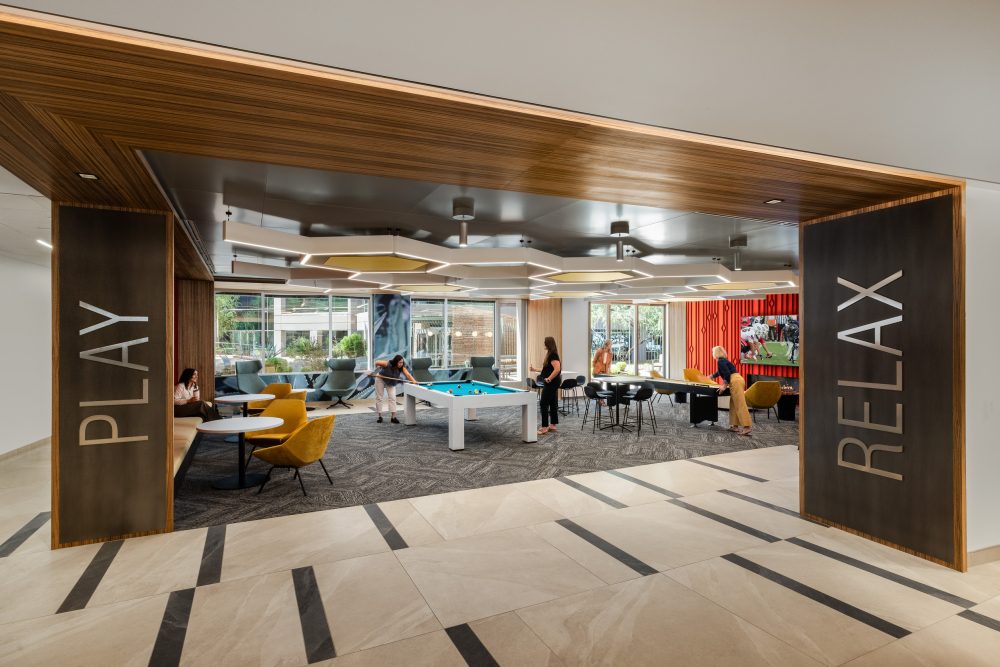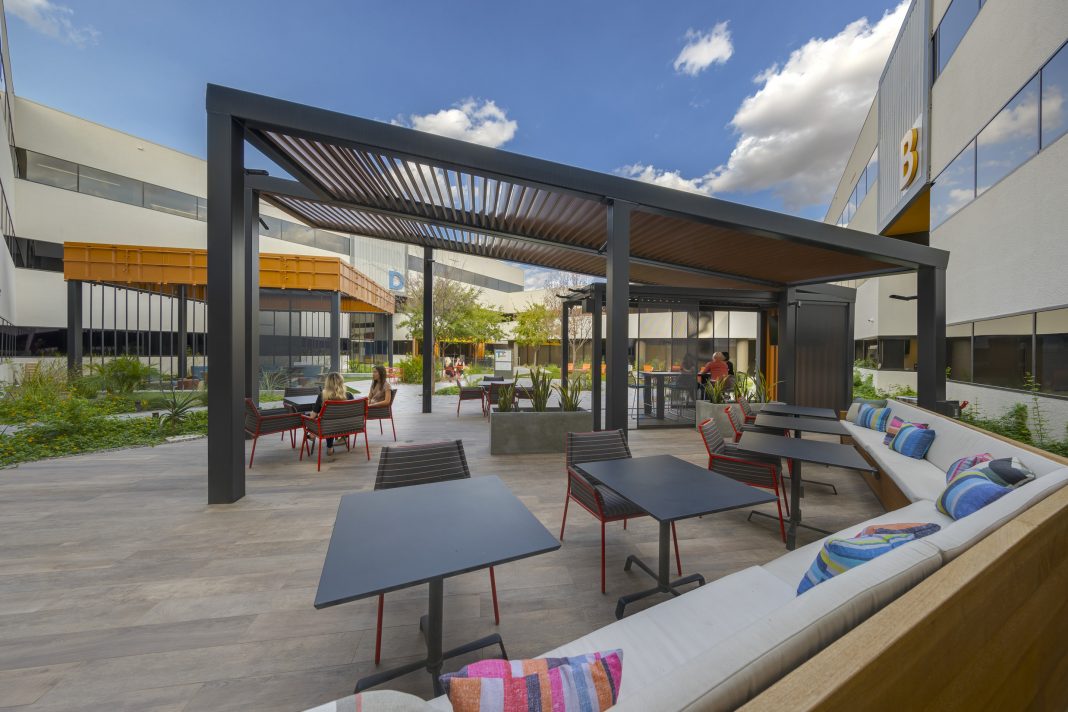Offices are starting to feel more like hotels or cafes and it’s no accident. Hospitality-inspired design is changing how we work, connect, and feel at the office.
The hospitality industry has become a source of inspiration in the world of workplace design, with companies taking cues from leading brands as they entice employees to spend more time in the office. In the broadest sense, hospitality refers to the friendly and generous reception and entertainment of guests and visitors–often involving food and drinks – to evoke an emotional connection and cultivate a sense of community. Hotels and luxury brands have mastered the art of anticipating and playing to an individual’s needs within a space even before the whisp of a desire begins to form. We now see and feel hospitality-type amenities and services being infused into corporate and commercial environments. Workplace design and digital experiences that prioritize warmth, feelings of welcoming and opportunities to connect with human experiences.
Community and connection, which were diminished during the era of remote work, are being vibrantly rekindled through innovative applications of hospitality design within the workplace.
This approach has not only brought people back together but has also ignited a renewed spirit of collaboration and shared purpose among teammates.
Over the past few years, hospitality design has transformed workplaces into dynamic environments where spontaneous interactions flourish, creativity is sparked and meaningful relationships are built. Integrating these inclusive, inviting environments has motivated individuals to reconnect with colleagues and created a renewed sense of belonging and unity within the workplace. It has also allowed us to create more than a place to work–it results in a thriving community where employees are inspired and energized to come together to achieve their best.

A New Era of Work Requires a New Approach to Design
The need for the office to take on a deeper meaning has driven the integration of new space typologies. Spaces like coworking hubs and café-style seating offer various work environments throughout the day and create a more residential and welcoming atmosphere, while biophilic design elements, natural materials and greenery enhance well-being and productivity. It is also important to keep in mind that hospitality-inspired design prioritizes accessibility, seamless and intuitive integration of technology and a focus on comfort that begins the moment one arrives at the office. Reception areas have started to take on arrival experiences akin to boutique hotels, featuring concierge-style desks and refreshment stations. Social hubs encourage spontaneous interactions and informal meetings, allowing users to relax and connect with colleagues with whom they might not typically interact. Attention to lighting, temperature control and acoustics improves comfort and wellbeing, while branded experiences that reflect company culture and values provide a sense of place and deepen connections between employees and their work.
Cultivating Community in the Workplace
The desire to cultivate community in the workplace has expanded beyond the confines of leased square footage to encompass a diverse array of amenities offered by commercial environments. Building owners have been challenged to rethink and reinvent the tenant experience, with many opting to adopt hospitality-enriched methodologies to attract and retain tenants. As a result, many employers are willing to pay premium rents for buildings that include high-end features such as lounges, fitness centers, basketball courts, spa-like showers and locker rooms, infrared saunas, expansive meeting spaces that open onto patios, game rooms, and ballroom-style multipurpose rooms that can be transformed into private party or lounge spaces equipped with a bar. In some cases, on-site food and coffee venues are also available.

Key Design Features
The office building has become an extension of the hospitality experience that begins at the front door. This shift has led to updated design strategies that feature:
Thoughtful Lighting: Creating a dynamic and welcoming atmosphere in hospitality-inspired spaces involves the thoughtful layering of lighting solutions that balance ambient, task and accent lighting. Ambient lighting provides overall illumination, setting a warm and inviting tone for the space. Task lighting focuses on specific activities, enhancing functionality and productivity and reducing eye strain. Accent lighting adds depth and dimension, highlighting architectural features, artwork or decorative elements to create visual interest. The interplay of these solutions results in a harmonious environment that feels comfortable and engaging.

Furniture Selections: Ancillary furniture plays a crucial role in hospitality-inspired spaces, where the right pieces can significantly enhance comfort, ergonomics, flexibility and scale. Engaging a qualified interior designer with the knowledge and expertise to select furniture that perfectly balances these elements will ensure that the concept and intent of a space is flawlessly executed. While ancillary furniture may come at a higher cost and have longer shipping timeframes, these pieces will most certainly elevate the overall workplace experience.
Abundant Access to Power: Ensuring easy access to power outlets for laptops and other devices is crucial in modern workplaces, as it supports productivity and convenience for employees.
Integrating charging stations and outlets throughout communal areas–including outdoor spaces–allows employees to stay connected and powered up, regardless of where they choose to work.
It is important to recognize that these installations can impact budgets, as they require careful planning and investment in infrastructure. By prioritizing accessible power solutions, companies demonstrate their commitment to creating a supportive and technologically advanced workplace that meets employees’ needs.
Integrating Technology and AI: The evolving world of technology will continue to break barriers and influence workplace design. Accommodating flexible infrastructure is necessary, though it can be unpredictable. Virtual meetings are here to stay, and connectivity, content sharing and seamless integration will remain priorities. Features like real-time translation, intelligent meeting summaries and automated task management will continue to help teams work more effectively.
Trial and Error: Creating a workplace that embraces and emphasizes hospitality-rich amenities and solutions involves introducing space types that go beyond traditional office layouts to nurture creativity and wellbeing. While some space types will immediately resonate with employees, others may evolve over time based on how they are used. A willingness to embrace flexibility, trial and error is essential to adapt and refine spaces to meet the dynamic needs of a company and its workforce. Imagine the possibilities: hammock lounges for relaxation, podcast rooms for content creation, libraries for quiet reflection, tech-free zones for digital detox and pet-friendly spaces to bring a touch of home to the office. This kind of creativity not only enhances the workplace experience but also contributes to a vibrant and engaging environment where employees feel valued and inspired.
The workplace has undergone a transformative reimagining, seamlessly blending community and connection with the flexibility of modern work schedules. Driven by hospitality-inspired design, this evolution is not just functional but deeply immersive and emotionally engaging, creating an environment that irresistibly draws people back to the office.


